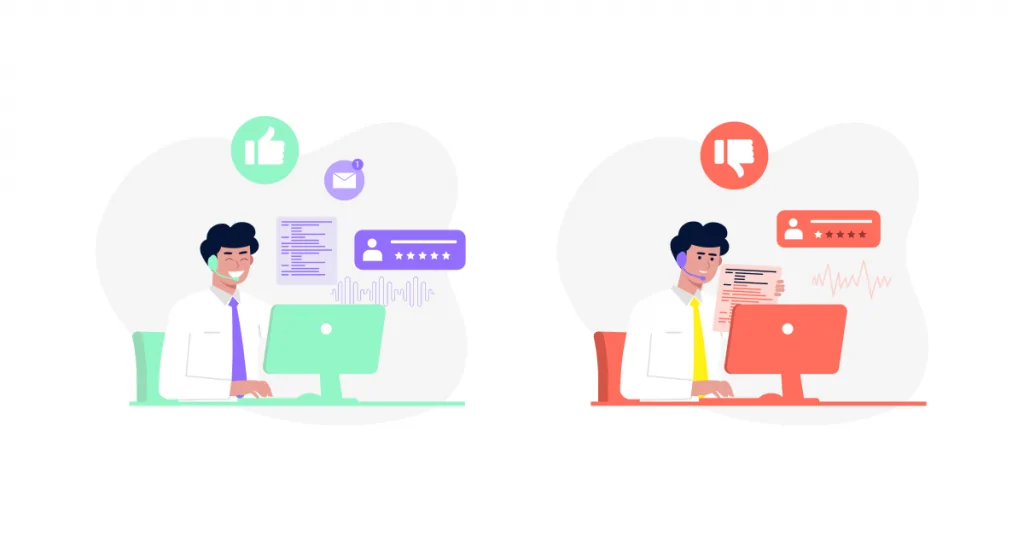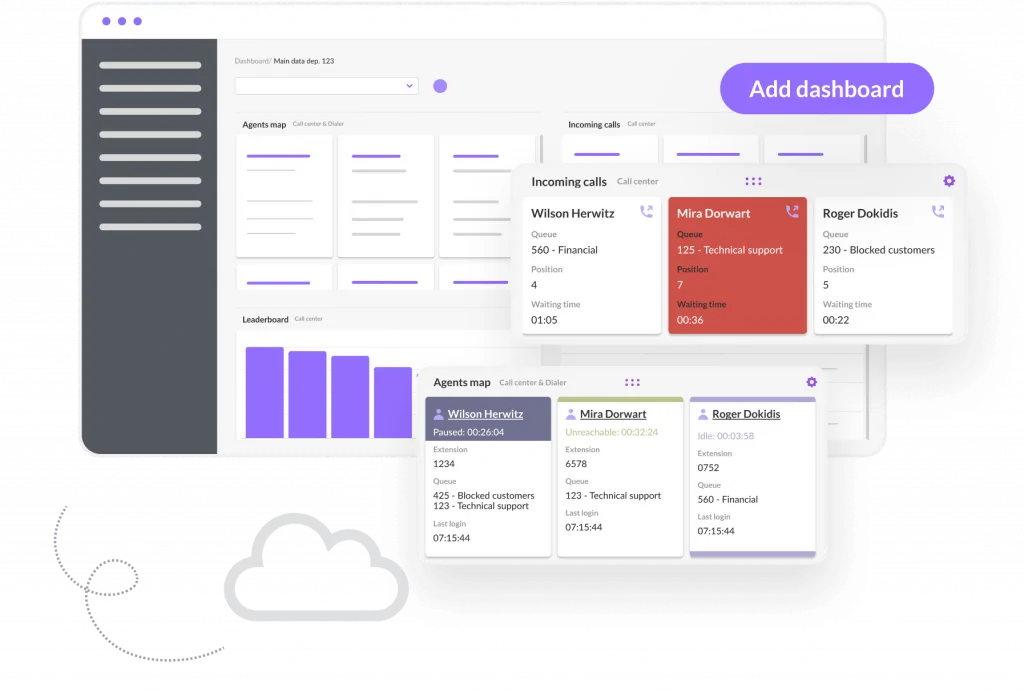Despite the rise and widespread adoption of digital communication channels and AI-driven chatbots, nearly 60% of consumers would still prefer to pick up the phone and call a company to reach customer support, according to a Salesforce study. And they naturally want to get quick, efficient, and highly personalized service. While many factors impact your team’s ability to deliver the level of support today’s consumers have come to expect – equipping your customer service agents with comprehensive call center scripts is an essential piece of the puzzle.
In this blog, we’ll talk about the importance of call center scripts for customer-facing teams, provide dozens of inbound call center script examples for various scenarios, and outline some best practices on how to use call center scripts effectively to ensure they work to the benefit of your customers and your support team.
What are Call Center Scripts?
Call center scripts, or customer service scripts, are reference guides that outline what call center agents are supposed to say on every call in response to different customer service scenarios, such as handling a complaint, transferring a call, resolving a tech issue, etc. Scripts guide agents through customer calls and help reduce errors, ensuring consistency across conversations and helping agents respond faster. They are often referred to as canned responses, although agents should always be flexible when using them and be able to adapt each script based on a particular situation.
Is Using Scripts Really a Good Idea?
When written and used properly, call center scripts can be incredibly helpful, especially for those reps who are just starting out and might not yet be confident enough when interacting with customers. These are some of the key benefits of using well-crafted scripts in call centers:
- Call center scripts empower newly hired agents with all the knowledge they need to respond quickly and confidently to various situations, reducing the Average Handle Times (AHT) and increasing First Call Resolution (FCR) rates.
- Having ready-made scripts ensures that agents always provide accurate information and consistent responses in every interaction, helping you maintain a unified brand voice and improve customer experience.
- Scripts help agents adhere to your company guidelines and regulatory requirements, minimizing the risk of compliance violations.

On the flip side, of course, if your reps rely too heavily on the script, they might sound robotic – and your customers may immediately recognize it, negatively impacting customer experience and customer satisfaction. That said, while scripts can greatly assist your team in handling customer interactions, they should be used wisely and naturally, allowing room for flexibility and personalization.
Inbound Call Center Script Examples for Customer-facing Teams
Below, we’ve collected effective call center scripts your customer service team can use as a reference when interacting with your customers across most common scenarios. Make sure to customize and adapt them to fit your unique brand voice.
Call center scripts for greeting customers and opening a conversation
According to research by McKinsey, 71% of consumers expect companies to deliver personalized interactions – and 76% get frustrated when this doesn’t happen. When interacting with existing customers, your reps should always try to personalize each interaction based on available customer data. Luckily, integrating your inbound call center software with your CRM system allows them to do just that by providing all the context and each customer’s interaction history. Here are a few examples of how to open a conversation with existing and new customers:
Greeting existing customers
- Good morning, [Customer Name]! It’s a pleasure to hear from you. This is [Agent Name]. What can I do for you today?
- Hi, [Customer Name], welcome back! My name is [Agent Name]. What brings you to us today?
- Thanks for calling again, [Customer Name]. I’m [Agent Name]. I see you were having an issue with [product name], is that right?
- Hi [Customer Name], welcome back to [Company Name]. This is [Agent Name]. Our records show that you purchased [product name] on [date]. Is that the product you need help with today?
Greeting new customers
- Hi, you’ve reached [Agent Name] from [Company Name]. How are you doing today?
- Welcome to [Company Name]! This is [Agent Name], and I’m happy to assist you today. What brings you our way?
- Hello, thanks so much for calling [Company Name]. I’m [Agent Name]. What can we do to make your day better?
- Thank you for considering [Company Name]. My name is [Agent Name]. Before we get started, can you please confirm your account number?
- Good morning/ afternoon/ evening! Thank you for calling [Company Name], we’re excited to have you. This is [Agent Name]. What can I help you with today?
Call center scripts for putting a customer on hold or transferring a call
A study by Software Advice found that waiting on hold even for one minute feels like too much for over 60% of consumers. On customer service calls, however, there will always be situations where you may need to put a customer on hold or transfer them to a different department or a specific customer service agent who is better equipped to assist them. When that happens, make sure to explain why you have to do it to better manage customer expectations. The following script examples have got you covered:
Putting a customer on hold
- I appreciate your patience, [Customer Name]. I’ll need just a moment to gather the necessary information for you. Is it alright if I put you on hold?
- Sorry for the inconvenience, [Customer Name]. I’m working on resolving your issue as quickly as possible. Please hold for a moment, and I’ll get back to you with an update shortly.
- Understood. Let me put you on hold for a moment while I check in with the [department] for your order details.
- Ok, I got it, [Customer Name]. Is it alright if I place you on a brief hold to look into that?
Transferring a call
- I completely understand [Customer Name]. Let me put you through to my supervisor so we can authorize the change on your order.
- Ok, [Customer Name], let’s get you to the right person. [Agent Name] knows exactly how to help you on this issue. I’m transferring you over now.
- I’m sorry, [Customer Name], it looks like this might be outside of my expertise. Let me go ahead and transfer you to [Agent Name] from [department] so they can assist you with your request.
- Thank you for your patience, [Customer Name]. I will need to transfer your call to [Agent name] who is the expert in this area. They’ll be with you in just a moment to take it from here.
Call center scripts for general support issues and troubleshooting
Based on the industry you are in, your team is likely to get lots of similar support requests. For example, late deliveries, incorrect orders, or damaged products are some of the most common issues faced by customer support teams in retail and e-commerce businesses. While these might seem insignificant, these types of issues might create a frustrating experience for your customers, negatively impacting their perception of your brand. Here’s how your customer care team can respond to these common situations professionally:
Delivery issues
- I’m so sorry that your [product name] never came. Let me look into your order to see what happened and how we can fix that.
- Thank you for providing that information, [Customer Name]. I see that your delivery is delayed for some reason. I’m going to escalate this issue to our shipping department and ensure that your order is prioritized for delivery.
- I apologize for the inconvenience, [Customer Name]. It looks like your order was shipped to the wrong address. I’ll go ahead and send out another one right away. Could you please confirm your address?
- I’m sorry to hear your package hasn’t arrived yet, [Customer Name]. I understand the urgency of receiving your delivery. Let me see how I can sort this out for you.
Damaged or missing products
- So sorry to hear that your product arrived damaged. Go ahead and ship the item back, and we will send you a new one at no additional cost. I’m going to create a return label for you now.
- I’m really sorry this has come up, [Customer Name]. Would you mind sending a photo of the damaged item so we can go ahead and finalize your replacement?
- I understand your frustration, [Customer Name]. So, just to confirm, everything came in except for the [product name]. Is that correct? Ok, we’ll be sending one out to you immediately.
- Please accept my apology, [Customer Name]. If you send me a photo of the damaged [product name], I’ll arrange for a replacement to be sent to you. Or, you are welcome to request a refund – the choice is yours.
Technical support issues
- I understand you are having problems with [product name]. Can you please walk me through the issue and anything you may have already tried to resolve it?
- Thank you for clarifying the issue, [Customer Name]. Let’s go over and try some troubleshooting steps together to get that fixed. First, could you please [describe specific steps]?
- [Product name] isn’t working, is that correct? Can you please tell me more about the issue you are experiencing so we can identify the root cause and fix that?
- I appreciate your cooperation, [Customer Name]. Let’s proceed with troubleshooting step by step. Have you tried to [describe action steps]?
Sharing self-help resources
- Thank you for explaining the problem, [Customer Name]. I can guide you through the process, or would you like me to send you the link to our support documentation?
- I understand the problem now. We actually have self-service resources that will help you solve that. Would you like me to share those with you?
- Thanks for the clarification, [Customer Name]. We have a video guide that explains this in detail. Would you like me to email it to you now?
- I got it, [Customer Name]. I can send you a step-by-step tutorial on how you can fix the issue. Would that be helpful?
Call center scripts for dealing with angry customers and complaints
Based on a Salesforce study, 84% of customers say the experience a company provides is as important as its products and services, and 66% are even willing to pay more for a great experience. The way your reps are prepared to handle complaints and requests from unsatisfied customers can often make a difference and turn a negative experience into an opportunity to delight and satisfy an angry customer. Whenever you have to deal with complaints or need to escalate an issue because a customer demands to speak to a manager, using the following scripts might be helpful:
Handling unhappy customers and complaints
- I’m really sorry you are not happy with your purchase. Let’s see what we can do to make things right for you.
- My apologies, [Customer Name]. I know that must have been very frustrating but we can get this taken care of. Let’s go over exactly what happened so I can fix this for you.
- I’m sorry this has happened, [Customer Name]. I understand your frustration, and I will do my best to help you.
- I appreciate you bringing this issue to my attention, [Customer Name]. I’d be just as upset if I were in your shoes. Let me see if I understand the situation correctly before we move forward.
Escalating an issue
- I’m so sorry this issue has come up, [Customer Name]. Let me put you through to my supervisor so we can fix that as soon as possible.
- Thank you for your patience, [Customer Name]. I want to assure you this is a top priority, and I’m escalating the issue to my manager. You can expect an update from us within 24 hours.
- I’m truly sorry that we weren’t able to resolve your issue today. I’m going to escalate this to the tech support team right away.
- Thank you for bringing this to our attention, [Customer Name]. I want to make sure we fix this quickly. I can escalate the issue to my manager now, or I can have them contact you directly. Which option would work best for you?
Call center scripts when you have to say no
As a customer service representative, you will occasionally have to deal with situations where you have to say no to a customer, whether it’s because your product or service doesn’t have that feature they are looking for or because your policy doesn’t allow you to fulfill their request. Just as with any other tricky customer service scenario, a little preparation goes a long way. The key is to make sure you are being polite and show a great deal of empathy. Below are some handful scripts you may use when you have to say no to a customer:
- I’m sorry for the inconvenience you’ve encountered. I completely understand your frustration. Unfortunately, as much as I want to help, our policy doesn’t allow us to fulfill your request at this time.
- I understand this is important to you. Unfortunately, we don’t have this feature at the moment. But we do intend to add it in future releases and we can notify you when it’s done. Would you like to receive an email update?
- I’m sorry, but it looks like this item is no longer available. But we do have similar options. Would you like me to tell you more about them?
- Unfortunately, we cannot lower the price for this item any further, but we have a similar product which is priced cheaper because it doesn’t have [feature name]. Would you be interested in exploring that option?
Call center scripts for ending a conversation
Regardless of the outcome, the way you wrap up the call is just as important as the way to open the conversation. Whether you’re providing a quick overview of a successful resolution or laying out the next steps to get the issue resolved – a professional ending helps ensure you leave a positive final impression on the customer, contributing to overall satisfaction with the interaction. With that in mind, here are some of the most effective ways to end a customer service conversation:
Successful resolution
- Thank you again for calling, [Customer Name]. If any other questions arise, please feel free to contact us at any time. Have a wonderful rest of your day!
- I’m glad we could take care of that for you, [Customer Name]. Thanks so much for calling. Enjoy the rest of your day!
- I’m happy we could sort this out, [Customer Name]. Is there anything else I can help you with today? Great! Thanks so much and have a nice day.
- We appreciate the call, [Customer Name]. Is there anything else I can do to help? Don’t hesitate to call back or email us if you have any other questions or concerns.
Unsuccessful resolution
- I’m truly sorry that we weren’t able to resolve this today, [Customer Name]. We are going to [explain the next steps] to fix this as soon as possible. May I contact you once we have a solution?
- I’m sorry but it’s not possible to fulfill your request at this time because [state the reason why]. Is it ok if I speak to my team and reach back to you once we come up with a resolution?
- I understand that this must be frustrating for you, and I apologize for the delay in resolving your issue. I’ll keep you updated on our progress.
- I’m sorry we couldn’t resolve this immediately, [Customer Name]. Can we schedule a follow-up call?
Cross-selling
- I’m so glad we could help and that you found exactly what you were looking for. By the way, we have something great to match your order. Mind if I share the details?
- I’m sure you are going to love [product name], and I should point out that many of our customers actually love to pair it with the [other product]. Would you like me to share a few details as I believe it might interest you?
- Before I let you go, there might be something else I can help you with. Based on the issue you faced, it sounds like you may also benefit from purchasing [product name]. It can help you resolve [restate the issue] by [explain how exactly it can help].
- I was happy to help you today. In case you didn’t know, many of our customers who enjoy [purchased product name] also really liked the [other product]. They perfectly complement each other because [briefly explain why].
How to Use Inbound Call Center Scripts Effectively
1. Avoid using negative statements
As a general rule of thumb, your scripts must be formulated in a positive way to ensure you make a good impression even when you have to deliver disappointing news to a customer. ‘I can’t help you with that’, ‘I don’t know’, ‘That’s not possible’, ‘It’s not my responsibility’, or ‘Sorry it’s just our company policy’ are just a few examples of phrases that you should avoid.
2. Go off the script for better personalization
There’s no one-size-fits-all approach when it comes to handling customer support requests. Be flexible and be ready to adapt to each unique situation by going off the script when you feel it’s appropriate. That can help you build rapport with customers, deliver a deeper level of personalization, and improve the overall experience for your customers.
3. Refine your scripts based on customer feedback
Review and refine your scripts regularly to ensure they resonate well with your customers. A great way to identify gaps and improvement opportunities is to review your call recordings and gauge customer sentiment from speech analytics software. Additionally, you can conduct CSAT surveys following customer service interactions and tweak your scripts based on customer feedback.
Leverage Call Center Technology to Serve Customers Better
While having ready-made call center templates and scripts can save your reps time and effort, empowering them to provide quick, efficient, and consistent responses across all interactions, you can further improve the experience for both your team and your customers with the right call center software solution.

With VoiceSpin, you can leverage a full range of inbound call management features, including multi-level IVR, custom call routing, and call queue management tools, to name just a few, to route inbound calls to the most relevant agents, increasing your FCR rates and CSAT scores. On top of that, VoiceSpin seamlessly integrates with 50+ leading CRM systems like HubSpot, Zoho, Salesforce, Pipedrive, and dozens more to give your team more context on every interaction and enable a more personalized support experience.
Get a personalized demo now to learn more about the features and whether VoiceSpin call center software is a good fit for your customer communication needs.



